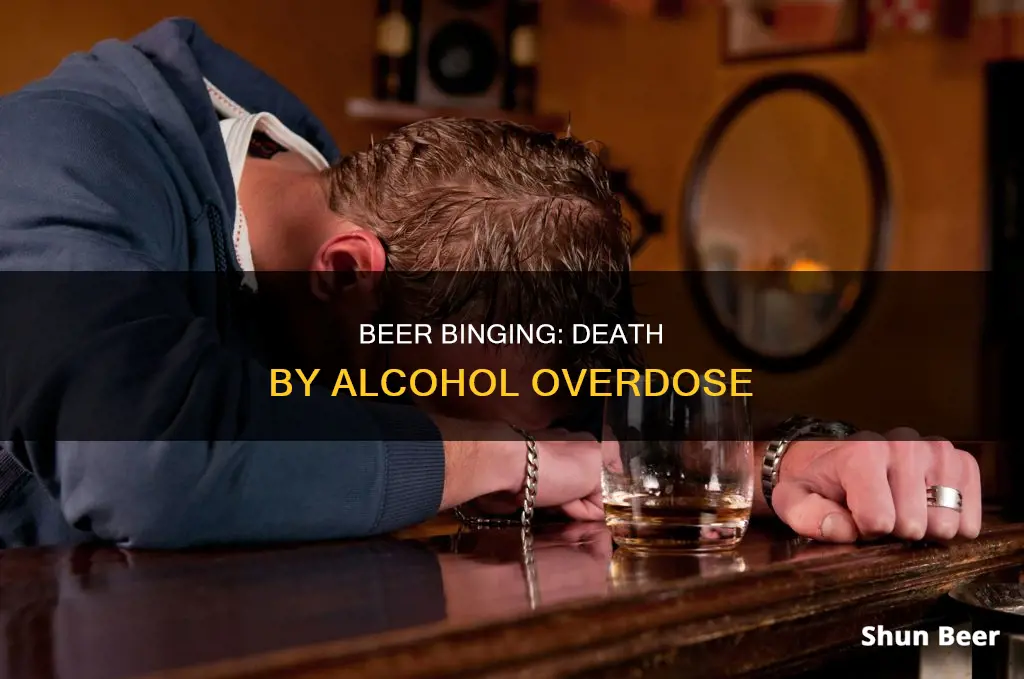
Drinking alcohol is a common social activity, but it is important to know your limits. While the occasional pint of beer or glass of wine is not harmful, excessive consumption can lead to serious health risks, including an increased chance of an early death. The amount of alcohol consumed is measured in units, with one unit containing 10ml or 8g of pure alcohol. The number of units in a drink depends on its size and alcohol strength. For example, a pint of strong lager can contain up to three units. It is recommended that men and women do not exceed 14 units per week, equivalent to around six pints of average-strength beer, and that these drinks are spread out over several days. Binge drinking, defined as consuming more than eight units for men or six units for women in a single session, is considered dangerous and can lead to long-term health issues. While the specific number of pints to reach fatal levels varies depending on individual factors, it is crucial to drink in moderation and be aware of the potential risks associated with excessive alcohol consumption.
| Characteristics | Values |
|---|---|
| Number of pints of beer that can kill you | It is not possible to determine a specific number. However, drinking 8 units or more (approximately a bottle of wine) per day increases the chance of an early death. |
| Safe drinking guidelines | Men and women are advised not to drink more than 14 units a week on a regular basis, which is around 6 pints of average-strength beer. |
| Binge drinking | Consuming more than 8 units (around 3 pints) for men or 6 units (around 2 large glasses) for women in a session is considered dangerous binge drinking. |
| Factors influencing alcohol tolerance | Weight, sex, drinking history, environment, and other individual factors can influence alcohol tolerance and the number of pints it takes to reach dangerous levels. |
What You'll Learn
- A pint of beer a day won't kill you, according to a study
- Binge drinking can lead to a range of deadly conditions in the long term
- A fatal overdose of alcohol is possible
- Factors like weight, sex, and drinking history influence alcohol tolerance
- The legal limit for driving is much lower than the fatal limit

A pint of beer a day won't kill you, according to a study
A pint of beer a day keeps the doctor away
It's long been said that a glass of red wine a day is good for your health, but according to a number of clinical studies, beer can have even greater health benefits.
Beer has a bad image
"Beer has a bad image – it is more often associated with drunken football crowds than health-conscious, discerning drinkers," says Dr George Philliskirk of The Institute of Brewing and Distillery, who specialises in yeast research. "But when drunk in moderation, beer provides a wider range of health benefits than wine."
Beer is less calorific than wine
Dr Philliskirk also points out that beer is often blamed for the dreaded beer belly, but this is a myth. "Glass for glass, beer is less calorific than wine," he says. "It is the lifestyle that gives a beer-drinker a belly, not the drinking itself."
Beer is more effective at rehydration than water
According to a study at the University of Granada in Spain, a single pint of beer is more effective at rehydrating the body than the equivalent amount of water. The scientists monitored 40 students – with half drinking beer and half drinking water after exercising in a 40C environment. They found that the carbon-dioxide bubbles in beer not only made the drink feel more thirst-quenching but increased water absorption, while the carbohydrates in beer replaced lost calories.
Beer is rich in vitamins and fibre
Beer is also rich in B vitamins and fibre. Just one pint contains about 10 per cent of your recommended daily intake of soluble fibre, while some varieties contain up to 30 per cent. Beer is also a good source of potassium, which is needed after exercise to help rehydrate.
Beer is good for your bones
Beer is rich in silica, a mineral vital for producing strong connective tissues and maintaining bone density. Professor Jonathan Powell, the head of MRC Human Nutrition Research at Cambridge University, says: “Beer could be considered as doubly good for bones – small amounts of ethanol [alcohol] inhibit bone loss, while the silica enhances the speed and quality of bone formation."
Beer is mildly antibacterial
The alcohol and hop content in beer also make it mildly antibacterial. Studies have found that regular beer drinking helps prevent the growth of helicobacter pylori bacteria, which leads to stomach ulcers. The hop content also promotes the secretion of gastric juices needed for effective digestion.
Beer is good for mothers
A study by the Spanish Paediatric Association found that the nutritional value of a mother’s milk was significantly higher in those drinking non-alcoholic beer.
Beer can help prevent Alzheimer's
Studies have shown that a small intake of alcohol can slow and even prevent age-related brain disease such as Alzheimer’s. Beer has the added benefit of being a more mentally stimulating drink, according to Dr Philliskirk. "People are more likely to drink wine alone than beer. Drinking beer has been a social occasion for centuries."
Half-Pint Whiskey: How Many Beers Does It Equal?
You may want to see also

Binge drinking can lead to a range of deadly conditions in the long term
Binge drinking is a pattern of drinking that increases an individual's blood alcohol concentration (BAC) to 0.08 grams per decilitre or more. This typically occurs when a man consumes five or more drinks, or a woman has four or more drinks, within a two-hour period. Binge drinking can lead to a range of deadly conditions in the long term.
Firstly, binge drinking increases the risk of acute harm, such as alcohol poisoning, blackouts, and overdoses. It also impairs judgement and coordination, increasing the likelihood of accidents, injuries, and unsafe sexual behaviour. This includes unprotected sex, multiple sexual partners, and exposure to sexually transmitted infections and unintended pregnancies.
Secondly, frequent binge drinking can cause long-term damage to the body, including the development of chronic diseases. The liver, which breaks down about 90% of the alcohol in the blood, can be particularly affected. Long-term heavy alcohol use can lead to alcoholic liver disease, including inflammation and cirrhosis. Binge drinking also increases the risk of several types of cancer, including head and neck, esophageal, liver, breast, and colorectal cancers.
Thirdly, binge drinking can negatively affect mental health and emotional well-being. Studies have shown that binge drinking is linked to heightened negative emotional states, including greater severity of depression, anxiety, and psychosis. It can also lead to alcohol dependence and alcohol use disorders.
Finally, binge drinking can have detrimental effects on specific organ systems in the body. It can cause high blood pressure, irregular heartbeat, and sudden death from heart failure. As a diuretic, alcohol causes the kidneys to produce more urine, leading to dehydration and low levels of essential minerals and salts. Alcohol also inhibits the gag reflex, increasing the risk of choking on vomit, and can cause inflammation or infection in the lungs.
What Makes Bock Beer Unique and Different?
You may want to see also

A fatal overdose of alcohol is possible
Alcohol is considered a hard drug, and a fatal overdose occurs when the blood alcohol content (BAC) reaches dangerously high levels. George Koob, director of the National Institute on Alcohol Abuse and Alcoholism, states that the danger zone for BAC is between 0.3% and 0.4%, and people have died at these levels. It is important to note that the amount of alcohol in the blood cannot be accurately measured with consumer-grade breathalyzers, so it is difficult for individuals to precisely track their BAC.
To put it into perspective, a standard drink typically contains 14 grams of pure alcohol. For an average-sized American, consuming 15 standard drinks in two hours could be life-threatening. Additionally, drinking a large amount of alcohol in a short period, such as downing an entire bottle of liquor, is considered a suicide attempt for most people.
While the number of pints of beer required to cause death may vary depending on various factors, excessive alcohol consumption can have severe consequences. It is important to drink in moderation and be aware of the potential risks associated with excessive alcohol intake. Binge drinking and long-term excessive alcohol consumption can increase the risk of developing deadly conditions such as heart disease, stroke, and certain types of cancer.
To maintain low health risks associated with alcohol consumption, the NHS recommends that men and women should not drink more than 14 units of alcohol per week on a regular basis. This recommendation translates to around six pints of average-strength beer or ten small glasses of lower-strength wine per week. It is also advised to spread the drinking over three or more days and include several drink-free days each week if one wishes to cut down their alcohol consumption.
Flight vs Growler Beer: What's the Difference?
You may want to see also

Factors like weight, sex, and drinking history influence alcohol tolerance
It is difficult to determine exactly how many pints of beer it would take to kill someone, as there are many factors at play. Factors like weight, sex, and drinking history influence alcohol tolerance.
Firstly, let's consider weight. The less a person weighs, the more they will be affected by a given amount of alcohol. People with a lower percentage of body fat will generally have lower blood alcohol content (BAC) than those with a higher percentage of body fat, even if they are the same weight and gender. This is because fat does not absorb alcohol, so those with more muscle mass can drink more without feeling the effects as strongly.
Sex is also a factor. Women tend to experience greater effects from alcohol than men when drinking the same amount. This is due to women having lower levels of dehydrogenase, the enzyme that breaks down alcohol in the stomach, resulting in higher BACs. Women also tend to have a higher percentage of body fat and a lower percentage of water in their bodies, which affects alcohol absorption and processing.
Finally, drinking history can play a role in alcohol tolerance. Those with a history of drinking will likely have a higher tolerance and may need to consume more alcohol to feel the same effects. However, it is important to note that developing tolerance can be a sign of a problematic relationship with alcohol.
Other factors that can influence alcohol tolerance include family history, the type of drink, how quickly it is consumed, food consumption, and health issues. It is important to understand these factors and their impact on alcohol tolerance to maintain safe and healthy drinking habits.
Salt Life Beverage LLC: Exploring Their Beer Variety
You may want to see also

The legal limit for driving is much lower than the fatal limit
It is important to understand that while drinking a pint of beer or a glass of wine a day may not increase your risk of dying, as suggested by a Canadian study, the legal limit for driving is much lower than the fatal limit. This means that you can still be within the legal drinking limits and not be fit to drive. The legal limit for driving in most places is typically around 0.08% blood alcohol content (BAC), which is the point at which you are considered too drunk to operate a vehicle safely. However, it is important to note that this limit varies by country and region, and it is always best to check the local laws and regulations.
The fatal limit, on the other hand, is much higher and is typically considered to be around 0.3% to 0.4% BAC. At this level, people have been known to die, and it is considered the "danger zone". It is important to note that the amount of alcohol that can cause a fatal overdose varies from person to person and depends on factors such as weight, sex, drinking history, and other individual factors. Therefore, it is crucial to be aware of your personal limits and to drink responsibly.
While the legal limit for driving is much lower than the fatal limit, it is important to understand that drinking and driving is never a good combination. Even if your BAC is below the legal limit, your reaction times and coordination can still be impaired, increasing the risk of an accident. Therefore, it is always best to avoid drinking and driving altogether and to find alternative means of transportation if you plan on consuming alcohol.
Additionally, it is worth noting that the legal drinking limits and the fatal limit are not the only considerations when it comes to alcohol consumption. Drinking too much alcohol, even if it doesn't result in a fatal overdose, can have negative consequences for your health and well-being. Excessive alcohol consumption can lead to a range of issues, including blackouts, impaired judgment, and an increased risk of developing long-term health conditions such as heart disease, stroke, and certain types of cancer. Therefore, it is important to drink in moderation and to be aware of the potential risks associated with excessive alcohol intake.
Explore Beer, Lager, and Bitter: Know Their Unique Differences
You may want to see also
Frequently asked questions
Drinking a pint of beer a day won't increase your risk of dying, according to a study by Canadian researchers. However, binge drinking and long-term excessive alcohol consumption can lead to deadly conditions such as heart disease, stroke, and cancer. The NHS recommends not exceeding 14 units per week, equivalent to around six pints of average-strength beer.
Binge drinking is defined as consuming more than eight units (approximately three pints) for men or six units for women in a single session. Binge drinking can be dangerous and lead to adverse health effects.
The amount of alcohol in a drink is measured by its alcohol by volume (ABV) or alcohol volume, usually expressed as a percentage. You can calculate the number of units in a drink by multiplying its volume (in milliliters) by its ABV and dividing the result by 1,000.
It's important to monitor your drinking habits and be aware of the recommended limits. If you find yourself regularly exceeding the weekly guidelines or engaging in binge drinking, it may be time to cut down. Additionally, drinking more than 14 standard drinks in one hour for an average-sized American male can lead to dangerous blood alcohol levels.
If you experience negative consequences due to your drinking, such as blackouts, health issues, or an inability to stop, you may have a problem with alcohol. It's important to seek professional help if you feel you cannot control your alcohol intake or if it interferes with your daily life.







